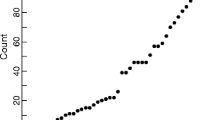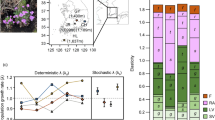Abstract
We compared the demography of two populations of Mammillaria huitzilopochtli, an endemic and threatened rupicolous cacti species with a narrow distribution in the semiarid Tehuacán-Cuicatlán region of central Mexico. Censuses were conducted over a 5-year period in two populations: a disturbed site (S1) and a well-preserved site (S2). Five annual size-based matrices and a mean transition matrix of each population were constructed to estimate demographic trends. Prospective time-invariant analyses were performed to calculate population growth rate and elasticities, whereas prospective stochastic analyses were performed to assess quasi-extinction probabilities and how simulated changes in recruitment, stasis and growth affected the population growth rate. Retrospective perturbation analyses (life table response experiments, LTREs) were used to explore the contributions of demographic processes, plant sizes, and temporal variability (years) to the observed variations in population growth rate. The species showed decreasing population growth rates for almost all years and sites, S1 showed lower population growth rates than S2. Quasi-extinction probabilities were 1 after 9 years for S1 and 17 years for S2. Elasticity values were highest for matrix entries corresponding to plants remaining in the same category (stasis) followed by growth and fecundity. LTREs showed that fecundity had negative contributions to population growth rates for all years in S1 population, while it had positive contributions in 4 out of 5 years in population S2. Prospective stochastic analyses showed that increasing recruitment by 50% could give population growth rates >1 in S2 while none of the simulations give this value in S1. Increasing survival also raises population growth rates but always below one. These results indicate that populations under the influence of human disturbance will eventually be lost. According to the models the most promising management strategy to conserve this species is to increase recruitment rates and to give special care to reproductive adults.





Similar content being viewed by others
References
Álvarez R, Godínez-Álvarez H, Guzmán U, Dávila P (2004) Aspectos ecológicos de dos cactáceas mexicanas amenazadas: implicaciones para su conservación. Bol Soc Bot Mex 75:7–16
Anderson EF (2001) The cactus family. Timber Press, Portland, Oregon, USA
Anderson EF, Arias-Montes S, Taylor NP (1994) Threatened cacti of Mexico. Royal Botanical Gardens, Kew, England
Arias S, Guzmán U, Mandujano MC, Soto GM, Golubov J (2005) Las especies mexicanas de cactáceas en riesgo de extinción I: Una comparación entre listados NOM-059-ECOL-2001 (México), la lista roja (UICN) y CITES. Cact Suc Mex 50:100–125
Bowers JE (2000) Does Ferocactus wislizeni (Cactaceae) have a between-year seed bank? J Arid Environ 45:197–205
Boyce MS, Haridas CV, Lee CT (2006) Demography in an increasingly variable world. Trends Ecol Evol 21:141–148
Bravo Hollis H (1978) Las Cactáceas de México. I. UNAM, México
Carrillo-Angeles IG, Golubov J, Rojas-Aréchiga M, Mandujano MC (2005) Distribución y estatus de conservación de Ferocactus robustus (Pfeiff.) Britton et. Rose. Cact Suc Mex 50:36–55
Caswell H (2001) Matrix population models: construction, analysis and interpretation, 2nd edn. Massachusetts, USA
Clark-Tapia R, Mandujano MC, Valverde T, Mendoza A, Molina-Freaner F (2005) How important is clonal recruitment for population maintenance in rare plant species? The case of the narrow endemic cactus, Stenocereus eruca, in Baja California, México. Biol Conserv 124:123–132
Cody ML (1993) Do cholla cacti (Opuntia spp., Subgenus Cylindropuntia) use or need nurse plants in the Mojave desert? J Arid Environ 24:139–154
Contreras C, Valverde T (2002) Evaluation of the conservation status of a rare cactus (Mammillaria crucigera) through the analysis of its population dynamics. J Arid Environ 51:89–102
De Kroon H, Plaisier A, van Groenedael J, Caswell H (1986) Elasticity: the relative contribution of demographic parameters to population growth rate. Ecology 67:1427–1431
Esparza-Olguín L, Valverde T, Vilchis-Anaya (2002) Demographic analysis of a rare columnar cactus (Neobuxbaumia macrocephala) in the Tehuacan Valley, México. Biol Conserv 103:349–359
Esparza-Olguín L, Valverde T, Mandujano MC (2005) Comparative demographic analysis of three Neobuxbaumia species (Cactaceae) with differing degree of rarity. Popul Ecol 47:229–245
Flores-Martínez A (2008) Estudio poblacional de Mammillaria huitzilopochtli D. R. Hunt en el Valle de Cuicatlán, Oaxaca, México. PhD Thesis, Universidad Autónoma Metropolitana, México, DF
Flores-Martínez A, Manzanero MG (2005) Método de evaluación de riesgo de extinción de Mammillaria huitzilopochtli D R. Hunt. Cact Suc Mex 50:15–26
Flores-Martínez A, Manzanero MG, Rojas-Aréchiga M, Mandujano MC, Golubov J (2008) Seed age germination responses and seedling survival of an endangered cactus species that inhabits cliffs. Nat Area J 28:51–57
Franco AC, Nobel P (1989) Effect of nurse plants on the microhabitat and growth of cacti. J Ecol 77:870–886
García MB (2003) Demographic viability of a relict population of the critically endangered plant Borderea chouardii. Conserv Biol 17:1672–1680
García MB, Guzmán D, Goñi D (2002) An evaluation of the status of five threatened plant species in the Pyrenees. Biol Conserv 103:151–161
García-Mendoza A, Tenorio LP, Reyes SJ (1994) El endemismo en la flora fanerogámica de la Mixteca Alta, Oaxaca-Puebla, México. Act Bot Mex 27:53–73
Godínez-Alvarez H, Valiente-Banuet A, Valiente-Banuet L (1999) Biotic interactions and the population dynamics of the long-lived columnar cactus Neobuxbaumia tetetzo in the Tehuacan Valley, Mexico. Can J Bot 77:203–208
Godínez-Alvarez H, Valverde T, Ortega-Baes P (2003) Demographic trends in the Cactaceae. Bot Rev 69:173–203
Golubov J, Mandujano MC, Franco M, Montaña C, Eguiarte L, López-Portillo J (1999) Demography of the invasive woody perennial Prosopis glandulosa (honey mesquite). J Ecol 87:955–962
Guzmán U, Arias S, Dávila P (2003) Catálogo de Cactáceas Mexicanas. CONABIO. Universidad Nacional Autónoma de México, México D. F., México
Horvitz C, Schemske DW, Caswell H (1997) The relative “importance” of life history stages to population growth: prospective and retrospective analysis. In: Tuljapurkar S, Caswell H (eds) Structured population models in marine, terrestrial and freshwater systems. Chapman and Hall, New York, pp 247–271
Jiménez-Sierra C, Mandujano MC, Eguiarte LE (2007) Are populations of the candy barrel cactus (Echinocactus platyacanthus) in the desert of Tehuacán, Mexico at risk? Population projection matrix and life table response analysis. Biol Conserv 135:278–292
Kephart SR, Paladino C (1997) Demographic change ad microhabitat variability in a grassland endemic, Silene douglasii var, oraria (Caryophyllaceae). Am J Bot 84:179–189
Mandujano MC, Montaña C, Méndez I, Golubov J (1998) The relative contributions of sexual reproduction and clonal propagation in Opuntia rastrera from two habitats in the Chihuahuan Desert. J Ecol 86:911–921
Mandujano MC, Montaña C, Franco M, Golubov J, Flores-Martínez A (2001) Integration of demographic annual variability in a clonal desert cactus. Ecology 82:344–359
Mandujano MC, Flores-Martínez A, Golubov J, Ezcurra E (2002) Spatial distribution of three globose cacti in relation to different nurse-plant canopies and bare areas. Southwest Nat 47:162–168
Mandujano MC, Golubov J, Huenneke LF (2007a) Effect of reproductive modes and environmental heterogeneity in the population dynamics of a geographically widespread clonal desert cactus. Popul Ecol 49:141–153
Mandujano MC, Verhulst JAM, Carrillo-Angeles IG, Golubov J (2007b) Population dynamics of Ariocarpus scaphirostris Bödeker (Cactaceae): evaluating the status of a threatened species. Int J Plant Sci 168:1035–1044
Martorell C, Patiño P (2006) Globose cacti (Mammillaria) living on cliffs avoid high temperatures in a hot dryland of Southern Mexico. J Arid Environ 67:541–552
Martorell C, Peters E (2005) On the measurement of chronic disturbance and its effects on the threatened cactus Mammillaria pectinifera. Biol Conserv 124:199–207
Menges E (2000) Population viability analysis in plants: challenges and opportunities. Trends Ecol Evol 15:51–56
Morris WF, Doak DF (2002) Quantitative conservation biology: theory and practice of population viability analysis. Sinauer Associates, Sunderland, MA, USA
Munguía-Rosas MA, Sosa VJ (2008) Nurse plants versus nurse objects: effects of woody plants and rocky cavities on the recruitment of the Pilosocereus leucocephalus columnar cactus. Ann Bot 101:175–185
Navarro L, Guitián J (2003) Seed germination and seedling survival of two threatened endemic species of the northwest Iberian Peninsula. Biol Conserv 109:313–320
Peters E, Martorell C (2000) Conocimiento y conservación de las Mamillarias endémicas del Valle de Tehuacán-Cuicatlán. R166. CONABIO. Instituto de Ecología, UNAM, México
Picó X, Riba M (2002) Regional-scale demography of Ramonda myconi: remnant population dynamics in a preglacial relict species. Plant Ecol 161:1–13
Rabinowitz D, Cairns S, Dillon T (1986) Seven kinds of rarity. In: Soule ME (ed) Conservation biology. Sinauer, Sunderland, Mass, pp 182–204
Ramula S (2008) Population dynamics of a monocarpic thistle: simulated effects of reproductive timing and grazing of flowering plants. Acta Oecol 33:231–239
Rosas MD, Mandujano MC (2002) La diversidad de historias de vida de cactáceas, aproximación por el triángulo demográfico. Cact Suc Mex 47:33–41
Schemske DW, Husband BC, Ruckelhaus MH, Goodwillie C, Parker IM, Bishop JG (1994) Evaluating approaches to the conservation of rare and endangered plants. Ecology 75:584–606
Schmalzel JR, Reichenbacher FW, Rutman S (1995) Demographic study of the rare Coryphantha robbinsorum (Cactaceae) in Southeastern Arizona. Madroño 42:332–348
SEMARNAT (2002) Norma Oficial Mexicana NOM-059-ECOL-2001. Diario Oficial de la Federación. 2a. sección. 06 marzo 2002
Shreve F (1931) Physical conditions in sun and shade. Ecology 12:96–104
Silvertown JW, Franco M, Pisanty I, Mendoza A (1993) Comparative plant demography––relative importance of life cycle components to the finite rate of increase in woody and herbaceous perennials. J Ecol 81:465–476
Stubben C, Miiligan B (2007) Estimating and analyzing demographic models using the popbio package in R. J Stat Softw 22:1–23
Svensson BM, Carlsson BA, Karlsson PS, Nordell KO (1993) Comparative long-term demography of three species of Pinguicula. J Ecol 81:635–645
Tickin T, Nantel P (2004) Dynamics of the tropical understrory herb Aechmea magdalenae in old-growth versus secondary forest. Biol Conserv 120:461–470
Valiente-Banuet A, Ezcurra E (1991) Shade as a cause of the association between the cactus Neobuxbaumia tetetzo and the nurse plant Mimosa luisana in the Tehuacan Valley, Mexico. J Ecol 79:961–971
Valverde PL, Zavala-Hurtado JA (2006) Assessing the ecological status of Mammillaria pectinifera Weber (Cactaceae), a rare and threatened species endemic of the Tehuacán-Cuicatlán Region in Central Mexico. J Arid Environ 64:193–208
Valverde T, Quijas S, López-Villavicencio M, Castillo S (2004) Population dynamics of Mammillaria magnimamma Haworth. (Cactaceae) in a lava-field in central Mexico. Plant Ecol 170:167–184
van Groenendael JM, Slim P (1988) The contrasting dynamics of two populations of Plantago lanceolata classified by age and size. J Ecol 76:585–599
Villaseñor JL, Dávila P, Chiang F (1990) Fitogeografía del Valle de Tehuacan-Cuicatlán. Bol Soc Bot Méx 50:135–149
Acknowledgments
This research is part of the doctoral studies of AFM at the Universidad Autónoma Metropolitana-Xochimilco (UAM-X) of Mexico under the advice of MMS, JG. We are grateful to the Cassiano Conzatti Botanical Garden of CIIDIR IPN Oaxaca for providing the facilities to carry out the experiments. Permit to collect fruits (SGPA/DGVS/00615) was granted by SEMARNAT, México. This research was supported by two CGPI–IPN projects (No. 20070431, 20080718) to AFM, project BBV BIOCON 04-084 CONACyT CB-2006-1 #62390 and CONACyT CB-2007-01 #83790 to JG, project 0350 SEMARNAT-CONACyT and PASPA-DGAPA-UNAM to MCM. We thank I. Rodriguez for field assistance, and Jerónimo Reyes for locating of populations of M. huitzilopochtli. This article was written during a sabbatical leave by JG and MCM at NMSU with B. Milligan who provided logistic support and helped implementing the popbio package.
Author information
Authors and Affiliations
Corresponding author
Rights and permissions
About this article
Cite this article
Martínez, A.F., Medina, G.I.M., Golubov, J. et al. Demography of an endangered endemic rupicolous cactus. Plant Ecol 210, 53–66 (2010). https://doi.org/10.1007/s11258-010-9737-6
Received:
Accepted:
Published:
Issue Date:
DOI: https://doi.org/10.1007/s11258-010-9737-6




